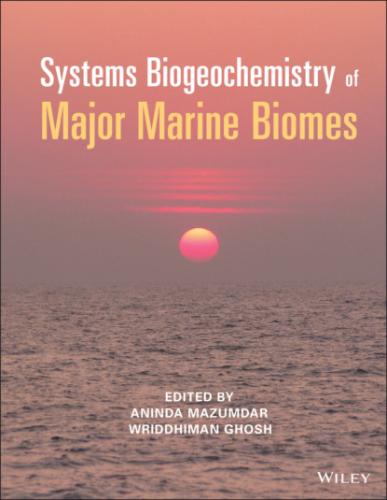65 Habicht, K., Canfield, D.E. and Rethmeier, J. (1998). Sulfur isotope fractionation during bacterial reduction and disproportionation of thiosulfate and sulfite. Geochimica et Cosmochimica Acta 62: 2585–2595. https://doi.org/10.1016/S0016‐7037(98)00167‐7
66 Hamersley, M.R., Lavik, G., Woebken, D. et al. (2007). Anaerobic ammonium oxidation in the Peruvian oxygen minimum zone. Limnology and Oceanography 52 (3): 923–933. https://doi.org/10.1016/S0016‐7037(98)00167‐7
67 Hartnett, H.E. and Devol, A.H. (2003). The role of a strong oxygen deficient zone in the preservation and degradation of organic matter: a carbon budget for the continental margins of NW Mexico and Washington. Geochimica et Cosmochimica Acta 67 (2): 247–264. https://doi.org/10.1016/S0016‐7037 (02)01076‐1
68 Hartnett, H.E., Keil, R.G., Hedges, J.I. et al. (1998). Influence of oxygen exposure time on organic carbon preservation in continental margin sediments. Nature 391: 2–4. https://doi.org/10.1038/35351
69 Hawley, A.K., Nobu, M.K., Wright, J.J. et al. (2017). Diverse Marinimicrobia bacteria may mediate coupled biogeochemical cycles along eco‐thermodynamic gradients. Nature Communications 8 (1): 1–10. https://doi.org/10.1038/s41467‐017‐01376‐9
70 Hedderich, R. and Whitman, W.B. (2006). Physiology and biochemistry of the methane‐producing Archaea. The Prokaryotes 2: 1050–1079. https://doi.org/10.1007/0‐387‐30742‐7_34
71 Hedges, J.I. and Keil, R.G. (1995). Sedimentary organic matter preservation: an assessment and speculative synthesis. Marine Chemistry 49 (2–3): 81–115.https://doi.org/10.1016/0304‐4203 (95)00008‐F
72 Heinrich, S.M. and Reeburgh, W.S. (1987). Anaerobic mineralization of marine sediment organic matter: rates and the role of anaerobic processes in the oceanic carbon economy. Geomicrobiology Journal 5: 191–237. https://doi.org/10.1080/01490458709385971
73 Helly, J. and Levin, L.A. (2004). Global distribution of naturally occurring marine hypoxia on continental margins. Deep Sea Research I 51: 1159–1168. https://doi.org/10.1016/j.dsr.2004.03.009
74 Hong, W.L., Torres, M.E., Kim, J.H. et al. (2014). Towards quantifying the reaction network around the sulfate–methane‐transition‐zone in the Ulleung Basin, East Sea, with a kinetic modeling approach. Geochimica et Cosmochimica Acta 140: 127–141. https://doi.org/10.1016/j.gca.2014.05.032
75 Hood, R.R., Wiggert, J.D. and Naqvi, S.W.A. (2009). Indian Ocean research: opportunities and challenges. Geophysical Monograph Series 185: 409–428. https://doi.org/10.1029/2007GM000714
76 Hu, C.Y., Yang, T.F., Burr, G.S. et al. (2017). Biogeochemical cycles at the sulfate‐methane transition zone (SMTZ) and geochemical characteristics of the pore fluids offshore southwestern Taiwan. Journal of Asian Earth Sciences 149: 172–183. https://doi.org/10.1016/j.jseaes.2017.07.002
77 Jessen, G.L., Lichtschlag, A., Ramette, A. et al. (2017). Hypoxia causes preservation of labile organic matter and changes seafloor microbial community composition (Black Sea). Science Advances 3 (2): e1601897. https://doi.org/10.1126/sciadv.1601897
78 Jørgensen, B.B. and Kasten, S. (2006). Sulfur cycling and methane oxidation. In: Marine Geochemistry, 2e (eds H.D. Schulz and M. Zabel), 271–309. Berlin: Springer.
79 Kalvelage, T., Lavik, G., Lam, P. et al. (2013). Nitrogen cycling driven by organic matter export in the South Pacific oxygen minimum zone. Nature Geosciences, 6 (3), 228–234. https://doi.org/10.1038/ngeo1739
80 Knittel, K. and Boetius, A. (2009). Anaerobic oxidation of methane: progress with an unknown process. Annual Review of Microbiology 63: 311–334. https://doi.org/10.1146/annurev. micro.61.080706.093130
81 Komada, T., Burdige, D.J., Li, H.L. et al. (2016). Organic matter cycling across the sulfate–methane transition zone of the Santa Barbara Basin, California Borderland. Geochimica et Cosmochimica Acta 176: 259–278. https://doi.org/10.1016/j.gca.2015.12.022
82 Kraal, P., Slomp, C.P., Reed, D.C. et al. (2012). Sedimentary phosphorus and iron cycling in and below the oxygen minimum zone of the northern Arabian Sea. Biogeosciences 9 (7): 2603–2624. https://doi.org/10.1016/j.gca.2015.12.022
83 Kristensen, E. (2000). Organic matter diagenesis at the oxic/anoxic interface in coastal marine sediments, with emphasis on the role of burrowing animals. In: Life at Interfaces and Under Extreme Conditions, Developments in Hydrobiology, Vol. 151 (eds. G. Liebezeit, S. Dittmann and I. Kröncke), 1–4. Dordrecht: Springer. https://doi.org/10.1007/978‐94‐011‐4148‐2_1
84 Kumar, S.P., Roshin, R.P., Narvekar, J. et al. (2009). Response of the Arabian Sea to global warming and associated regional climate shift. Marine Environment Research 68 (5): 217–222. https://doi.org/10.1016/j.marenvres.2009.06.010
85 Lachkar, Z., Lévy, M. and Smith, K.S. (2019). Strong intensification of the Arabian Sea oxygen minimum zone in response to Arabian Gulf warming. Geophysical Research Letters 46 (10): 5420–5429. https://doi.org/10.1029/2018GL081631
86 Lallier‐Verges, E., Bertrand, P. and Desprairies, A. (1993). Organic matter composition and sulfate reduction intensity in Oman Margin sediments. Marine Geology 112 (1–4), 57–69. https://doi.org/10.1016/0025‐3227 (93)90161‐N
87 Lam, P., Lavik, G., Jensen, M.M. et al. (2009). Revising the nitrogen cycle in the Peruvian oxygen minimum zone. Proceedings of the National Academy of Sciences 106 (12): 4752–4757. https://doi.org/10.1073/pnas.0812444106
88 Lam, P., Jensen, M.M., Kock, A. et al. (2011). Origin and fate of the secondary nitrite maximum in the Arabian Sea. Biogeosciences 8 (6): 1565–1577. https://doi.org/10.5194/bg‐8‐1565‐2011
89 Lamont, P.A. and Gage, J.D. (2000). Morphological responses of macrobenthic polychaetes to low oxygen on the Oman continental slope, NW Arabian Sea. Deep Sea Research Part II: Topical Studies in Oceanography 47 (1–2): 9–24. https://doi.org/10.1016/S0967‐0645 (99)00102‐2
90 Law, G.T., Shimmield, T.M., Shimmield, G.B. et al. (2009). Manganese, iron and sulphur cycling on the Pakistan margin. Deep Sea Research Part II: Topical Studies in Oceanography 56 (6–7): 305–323. https://doi.org/10.1016/S0967‐0645 (99)00102‐2
91 Levin,
